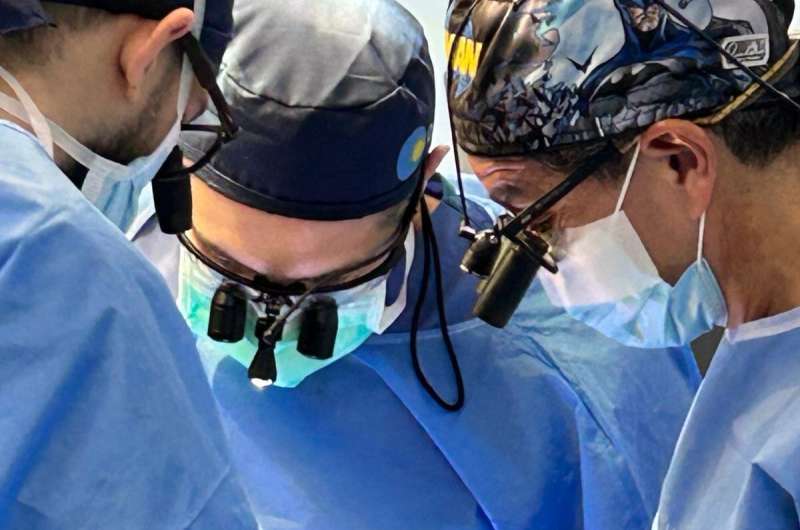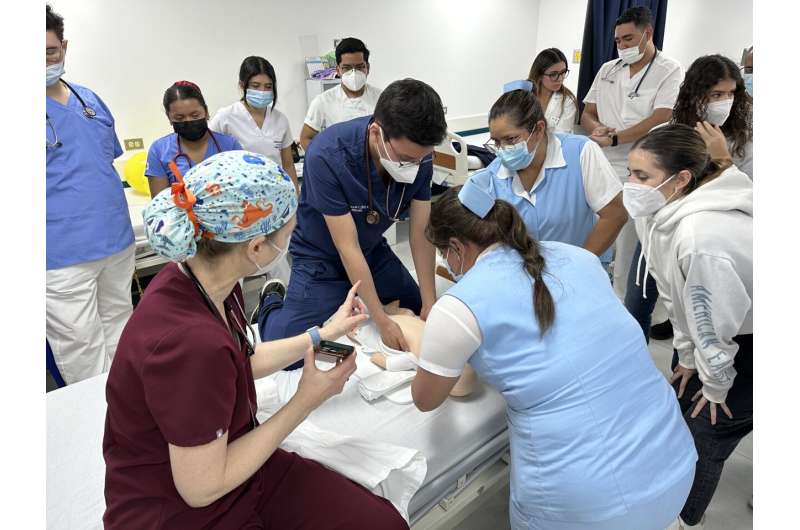This article has been reviewed according to Science X's editorial process and policies. Editors have highlighted the following attributes while ensuring the content's credibility:
fact-checked
peer-reviewed publication
trusted source
proofread
Generative AI used to create translatable pediatric care educational videos for hospitals in resource-poor countries

A team of pediatric clinicians at Mass General Brigham have turned to generative artificial intelligence (AI) to tackle problems plaguing child medical care delivery in resource-poor countries that increase risk for poor outcomes and mortality.
The clinicians developed a series of 45 multilingual videos, each ranging from three to eight minutes long, designed to educate providers around the world on pediatric care topics touching on teamwork, how to improve interpersonal communication, "How I Do It" surgical procedures, as well as focused guidance in delivering anesthesia, intensive care unit care, ward nursing and transitions from hospital to home.
The videos were recorded in English then translated to Spanish, emphasizing Latin American variations, using OpenAI's generative AI large language model, GPT-4. The videos were then enriched with synthetic voice avatars of native speakers.
The videos were designed to be viewed on smartphones, which are more accessible than laptops in some health care settings. The clinicians described their experiences and videos in a paper, titled "Overcoming Language Barriers in Pediatric Care: A Multilingual, AI Driven Curriculum for Global Healthcare Education," published in Frontiers in Public Health.
According to senior study author Christopher Hartnick, MD, the impetus for creating these videos was inspired through experiences with a foundation he co-founded called CareWays Collaborative, a nonprofit global health mission organization affiliated with Mass Eye and Ear and Massachusetts General Hospital, members of Mass General Brigham.
Hartnick, who is director of the Pediatric Otolaryngology Division at Mass Eye and Ear, helped start the collaborative with study fellow senior-author Phoebe Yager, MD, chief of the Division of Pediatric Critical Care Medicine at Mass General for Children, following his work with another global health nonprofit he oversees focusing on airway surgeries, Operation Airway.
One tragic memory that stuck with him was when he was in El Salvador performing airway surgeries, he noticed an infant who was not a patient of his laying in the ward, without sedation, who had been intubated with a poorly-taped breathing tube that was the size of what a 14-year-old would need. He learned that child died the next day.
"What became clear as a I took a step back was that a lot of children in these countries were getting sick and dying from things like sepsis and trauma, and would wind up in ICUs needing the type of collaborative care that we taught with airway surgery," said Hartnick, who is also professor of otolaryngology—head and neck surgery at Harvard Medical School.
"We asked how often do these errors occur and what can we do to help? It was evident that we needed to help teach a culture of care and to better understand the existing clinical knowledge gaps so we could best address them head on."
During two mission trips to Guatemala and Colombia, the authors conducted needs assessments from the medical staff to guide which questions would be needed for the educational videos. Using these insights, pediatric clinicians created concise narrated videos recorded at Mass General Brigham sites to encapsulate key aspects of pediatric care, providing teachings on surgical procedures, perioperative care, patient journeys and directing to educational resources with best-practice guidelines for patients and caregivers.
Hartnick then turned to a member of his lab who designs innovative otolaryngology tools, Fouzi Benboujja, Ph.D., and also enlisted his daughter, Elizabeth Hartnick, an applied math major at Brown University, to manage the technical aspects of using GPT4 and video software to translate these videos and develop synthetic voice profiles to match authentic local speech.
Each video gets organized into sub-specialty-specific chapters within the Canvas educational platform, and the researchers hope this categorization can help providers search easily for information most pertinent to them. For example, there are 19 instructional videos for pediatric intensivists, including video instruction on "how to tape and secure an endotracheal tube," "how to dress, access and care for a central venous catheter" and "how to prevent ventilator-related pneumonias."

Thus far the videos have been distributed in Guatemala, including to a group of 150 nurses, and Colombia, garnering positive feedback. The researchers plan to track patient outcomes for complications and mortality in hospitals and whether these videos might offer a positive impact. They also plan to translate to the videos in other languages.
"It is so exciting to harness the power of AI to translate this video-based curriculum into multiple languages in such an efficient manner," said Yager. "This ability to broaden the reach of our curriculum centered around multidisciplinary care captures our longstanding mission to foster inclusivity and communication in global health."
With further refining of large-language models, such tools have potential to disrupt how medical education is provided, according to Hartnick.
"Global health has been constrained by language issues across the world," he said. "Once you translate the needs of providers in other countries, you need to respond to their needs. Generative AI provides a way to translate into a format they can understand and process in their work."
More information: Fouzi Benboujja et al, Overcoming language barriers in pediatric care: a multilingual, AI-driven curriculum for global healthcare education, Frontiers in Public Health (2024). DOI: 10.3389/fpubh.2024.1337395




















